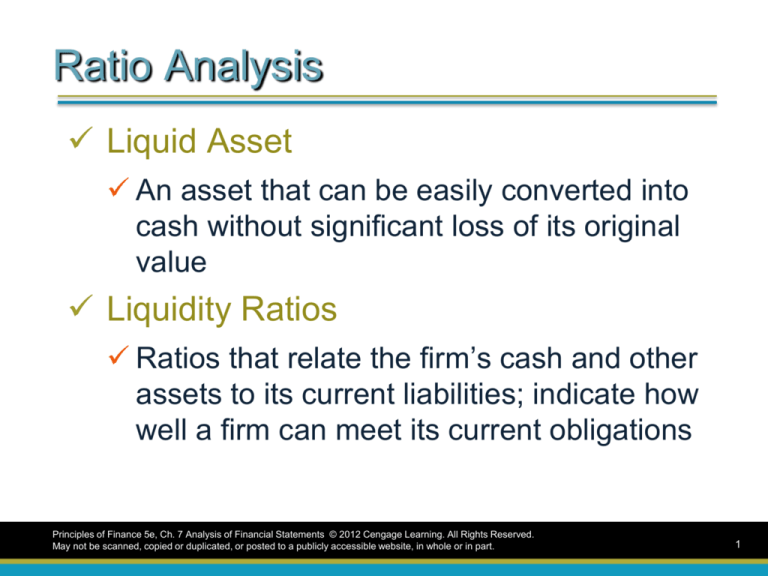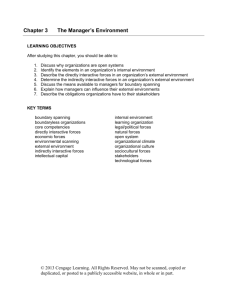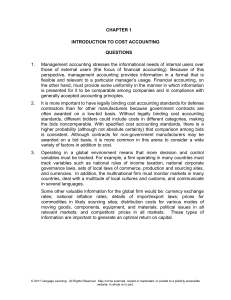
Ratio Analysis
Liquid Asset
An asset that can be easily converted into
cash without significant loss of its original
value
Liquidity Ratios
Ratios that relate the firm’s cash and other
assets to its current liabilities; indicate how
well a firm can meet its current obligations
Principles of Finance 5e, Ch. 7 Analysis of Financial Statements © 2012 Cengage Learning. All Rights Reserved.
May not be scanned, copied or duplicated, or posted to a publicly accessible website, in whole or in part.
1
Ratio Analysis
Current Ratio
Indicates the extent to which current
liabilities are covered by assets expected to
be converted into cash in the near future
Current assets
Current ratio =
Current liabilities
Principles of Finance 5e, Ch. 7 Analysis of Financial Statements © 2012 Cengage Learning. All Rights Reserved.
May not be scanned, copied or duplicated, or posted to a publicly accessible website, in whole or in part.
2
Ratio Analysis
Quick (acid test) Ratio
Deducts inventories from current assets
and divides the remainder by current
liabilities
A variation of the current ratio
Current assets - Inventory
Quick ratio =
Current liabilities
Principles of Finance 5e, Ch. 7 Analysis of Financial Statements © 2012 Cengage Learning. All Rights Reserved.
May not be scanned, copied or duplicated, or posted to a publicly accessible website, in whole or in part.
3
Ratio Analysis
Asset Management Ratios
Ratios that measure how effectively a firm
is managing its assets
Principles of Finance 5e, Ch. 7 Analysis of Financial Statements © 2012 Cengage Learning. All Rights Reserved.
May not be scanned, copied or duplicated, or posted to a publicly accessible website, in whole or in part.
4
Ratio Analysis
Inventory Turnover Ratio
Cost of goods sold Variable operating costs
=
=
Inventory
Inventory
Principles of Finance 5e, Ch. 7 Analysis of Financial Statements © 2012 Cengage Learning. All Rights Reserved.
May not be scanned, copied or duplicated, or posted to a publicly accessible website, in whole or in part.
5
Ratio Analysis
Days Sales Outstanding (DSO)
Receivables
Receivables
=
=
Average sales per day é Annual sales ù
êë
ú
û
360
Principles of Finance 5e, Ch. 7 Analysis of Financial Statements © 2012 Cengage Learning. All Rights Reserved.
May not be scanned, copied or duplicated, or posted to a publicly accessible website, in whole or in part.
6
Ratio Analysis
Fixed Assets Turnover Ratio
Sales
=
Net fixed assets
Principles of Finance 5e, Ch. 7 Analysis of Financial Statements © 2012 Cengage Learning. All Rights Reserved.
May not be scanned, copied or duplicated, or posted to a publicly accessible website, in whole or in part.
7
Ratio Analysis
Total Assets Turnover Ratio
Sales
=
Total assets
Principles of Finance 5e, Ch. 7 Analysis of Financial Statements © 2012 Cengage Learning. All Rights Reserved.
May not be scanned, copied or duplicated, or posted to a publicly accessible website, in whole or in part.
8
Ratio Analysis
Debt management ratios
Analyze the company’s use of debt
Financial leverage
The use of debt financing
Principles of Finance 5e, Ch. 7 Analysis of Financial Statements © 2012 Cengage Learning. All Rights Reserved.
May not be scanned, copied or duplicated, or posted to a publicly accessible website, in whole or in part.
9
Ratio Analysis
Debt Ratio
Total liabilities
=
Total assets
Principles of Finance 5e, Ch. 7 Analysis of Financial Statements © 2012 Cengage Learning. All Rights Reserved.
May not be scanned, copied or duplicated, or posted to a publicly accessible website, in whole or in part.
10
Ratio Analysis
Times-Interest-Earned (TIE) Ratio
EBIT
=
Interest Charges
Principles of Finance 5e, Ch. 7 Analysis of Financial Statements © 2012 Cengage Learning. All Rights Reserved.
May not be scanned, copied or duplicated, or posted to a publicly accessible website, in whole or in part.
11
Ratio Analysis
Fixed Charge Coverage Ratio
=
(
EBIT+Lease payments
é Sinking fund payment ù
Interest +
Lease
+ê
ú
charges
payments ë
(1-Tax rate)
û
)(
)
Principles of Finance 5e, Ch. 7 Analysis of Financial Statements © 2012 Cengage Learning. All Rights Reserved.
May not be scanned, copied or duplicated, or posted to a publicly accessible website, in whole or in part.
12
Ratio Analysis
Profitability Ratios
Ratios showing the effect of liquidity, asset
management, and debt management on
operating results
Principles of Finance 5e, Ch. 7 Analysis of Financial Statements © 2012 Cengage Learning. All Rights Reserved.
May not be scanned, copied or duplicated, or posted to a publicly accessible website, in whole or in part.
13
Ratio Analysis
Net Profit Margin on Sales
Net profit
=
Sales
Principles of Finance 5e, Ch. 7 Analysis of Financial Statements © 2012 Cengage Learning. All Rights Reserved.
May not be scanned, copied or duplicated, or posted to a publicly accessible website, in whole or in part.
14
Ratio Analysis
Return on Total Assets (ROA)
Net income
=
Total assets
Principles of Finance 5e, Ch. 7 Analysis of Financial Statements © 2012 Cengage Learning. All Rights Reserved.
May not be scanned, copied or duplicated, or posted to a publicly accessible website, in whole or in part.
15
Ratio Analysis
Return On Common Equity (ROE)
æ Net income available
çç
è to common stockholders
=
Total assets
Principles of Finance 5e, Ch. 7 Analysis of Financial Statements © 2012 Cengage Learning. All Rights Reserved.
May not be scanned, copied or duplicated, or posted to a publicly accessible website, in whole or in part.
ö
÷÷
ø
16
Ratio Analysis
Market Value Ratios
Ratios that relate the firm’s stock price to its
earnings and book value per share
Principles of Finance 5e, Ch. 7 Analysis of Financial Statements © 2012 Cengage Learning. All Rights Reserved.
May not be scanned, copied or duplicated, or posted to a publicly accessible website, in whole or in part.
17
Ratio Analysis
Earnings Per Share (EPS)
Principles of Finance 5e, Ch. 7 Analysis of Financial Statements © 2012 Cengage Learning. All Rights Reserved.
May not be scanned, copied or duplicated, or posted to a publicly accessible website, in whole or in part.
18
Ratio Analysis
Price/Earnings (P/E) Ratio
Market price per share
=
Earnings per share
Principles of Finance 5e, Ch. 7 Analysis of Financial Statements © 2012 Cengage Learning. All Rights Reserved.
May not be scanned, copied or duplicated, or posted to a publicly accessible website, in whole or in part.
19
Ratio Analysis
Book Value Per Share
Common equity
=
Number of common shares outstanding
Principles of Finance 5e, Ch. 7 Analysis of Financial Statements © 2012 Cengage Learning. All Rights Reserved.
May not be scanned, copied or duplicated, or posted to a publicly accessible website, in whole or in part.
20
Ratio Analysis
Market/Book (M/B) Ratio
Market price per share
=
Book value per share
Principles of Finance 5e, Ch. 7 Analysis of Financial Statements © 2012 Cengage Learning. All Rights Reserved.
May not be scanned, copied or duplicated, or posted to a publicly accessible website, in whole or in part.
21
Ratio Analysis
Trend Analysis
An analysis of a firm’s financial ratios over
time
Used to determine improvement or
deterioration in its financial situation
Principles of Finance 5e, Ch. 7 Analysis of Financial Statements © 2012 Cengage Learning. All Rights Reserved.
May not be scanned, copied or duplicated, or posted to a publicly accessible website, in whole or in part.
22
Ratio Analysis
Summary of ratio analysis:
The Du Pont Analysis
An analysis designed to show the
relationships among return on investment,
asset turnover, the profit margin, and
leverage
Principles of Finance 5e, Ch. 7 Analysis of Financial Statements © 2012 Cengage Learning. All Rights Reserved.
May not be scanned, copied or duplicated, or posted to a publicly accessible website, in whole or in part.
23
Ratio Analysis
Du Pont Equation
ROA = Net profit margin ´ Total assets turnover
=
Net income
Sales
´
Sales
Total Assets
Principles of Finance 5e, Ch. 7 Analysis of Financial Statements © 2012 Cengage Learning. All Rights Reserved.
May not be scanned, copied or duplicated, or posted to a publicly accessible website, in whole or in part.
24
Ratio Analysis
Comparative ratio analysis
(benchmarking)
An analysis based on a comparison of a
firm’s ratios with those of other firms in the
same industry
Principles of Finance 5e, Ch. 7 Analysis of Financial Statements © 2012 Cengage Learning. All Rights Reserved.
May not be scanned, copied or duplicated, or posted to a publicly accessible website, in whole or in part.
25
Uses and Limitations of Ratio Analysis
1. Large firms operate divisions in different
industries
Difficult to develop meaningful industry averages
2. If the goal is to be better than average,
industry averages are not the target
Focus on the industry leaders’ ratios
Principles of Finance 5e, Ch. 7 Analysis of Financial Statements © 2012 Cengage Learning. All Rights Reserved.
May not be scanned, copied or duplicated, or posted to a publicly accessible website, in whole or in part.
26
Uses and Limitations of Ratio Analysis
3. Inflation distorts balance sheets
Depreciation and inventory costs affect
income statements
Comparative analysis of firm over time
Comparing firms of different ages
Principles of Finance 5e, Ch. 7 Analysis of Financial Statements © 2012 Cengage Learning. All Rights Reserved.
May not be scanned, copied or duplicated, or posted to a publicly accessible website, in whole or in part.
27
Uses and Limitations of Ratio Analysis
4. Seasonal factors distort ratios
Use monthly averages as base for
inventory and receivables instead of one
particular month
5. Window dressing techniques
Make financial statements appear better
than they actually are
Borrowing “long-term” to be repaid quickly
distorts liquidity ratios
Principles of Finance 5e, Ch. 7 Analysis of Financial Statements © 2012 Cengage Learning. All Rights Reserved.
May not be scanned, copied or duplicated, or posted to a publicly accessible website, in whole or in part.
28
Uses and Limitations of Ratio Analysis
6. Different accounting practices
Distorts comparisons
Inventory valuation
Depreciation methods
Principles of Finance 5e, Ch. 7 Analysis of Financial Statements © 2012 Cengage Learning. All Rights Reserved.
May not be scanned, copied or duplicated, or posted to a publicly accessible website, in whole or in part.
29
Uses and Limitations of Ratio Analysis
7. Difficult to generalize about “good” or “bad”
ratios
High current ratio can indicate strong
liquidity or excessive cash
High fixed assets turnover can indicate
efficient use or undercapitalized
Principles of Finance 5e, Ch. 7 Analysis of Financial Statements © 2012 Cengage Learning. All Rights Reserved.
May not be scanned, copied or duplicated, or posted to a publicly accessible website, in whole or in part.
30
Uses and Limitations of Ratio Analysis
8. Firm may have some “good” ratios and
others that look “bad”
Difficult to tell whether overall the
company is strong or weak
Statistical procedures can analyze the net
effects of a set of ratios
Principles of Finance 5e, Ch. 7 Analysis of Financial Statements © 2012 Cengage Learning. All Rights Reserved.
May not be scanned, copied or duplicated, or posted to a publicly accessible website, in whole or in part.
31
Chapter Principles
Key Analysis of Financial Statements Concepts
What financial statements do corporations publish,
and what information does each provide?
Balance sheet - a snapshot of firm’s assets and
how they are financed
Income statement - revenues earned and
expenses incurred are netted to compute the
bottom line
Statement of cash flows - activities that generated
funds and those that used funds
Statement of retained earnings - shows what
caused changes in the firm’s common equity
Principles of Finance 5e, Ch. 7 Analysis of Financial Statements © 2012 Cengage Learning. All Rights Reserved.
May not be scanned, copied or duplicated, or posted to a publicly accessible website, in whole or in part.
32
Chapter Principles
Key Analysis of Financial Statements Concepts
How do investors utilize financial statements?
Help investors determine the financial position of the firm to
help estimate cash flows the firm will generate in the future
What is ratio analysis and why are the results
important to both managers and investors?
Is used to evaluate the firm’s current financial
position and the direction this position is expected
to take in the future
Investors form opinions about the safety of their
investments
Managers plan actions that will correct the firm’s
weaknesses and take advantage of its strengths
Principles of Finance 5e, Ch. 7 Analysis of Financial Statements © 2012 Cengage Learning. All Rights Reserved.
May not be scanned, copied or duplicated, or posted to a publicly accessible website, in whole or in part.
33
Chapter Principles
Key Analysis of Financial Statements Concepts
What are some potential problems associated
with financial statement analysis?
Classifying a large conglomerate firm into an
industry category or finding firms to compare
Inflation can distort numbers
Seasonal firms have wide swings in their operating
accounts
Firms can use GAAP to manipulate financial
numbers
Difficult to form conclusions when some ratios look
good and others look bad.
Principles of Finance 5e, Ch. 7 Analysis of Financial Statements © 2012 Cengage Learning. All Rights Reserved.
May not be scanned, copied or duplicated, or posted to a publicly accessible website, in whole or in part.
34
Chapter Principles
Key Analysis of Financial Statements Concepts
What is the most important ingredient in
financial statement analysis?
Judgment must be used when interpreting financial
ratios and therefore different analysts might reach
different conclusions
Conclusions might not always be correct
Principles of Finance 5e, Ch. 7 Analysis of Financial Statements © 2012 Cengage Learning. All Rights Reserved.
May not be scanned, copied or duplicated, or posted to a publicly accessible website, in whole or in part.
35
End of Chapter 7
Analysis of
Financial
Statements
Principles of Finance 5e, Ch. 7 Analysis of Financial Statements © 2012 Cengage Learning. All Rights Reserved.
May not be scanned, copied or duplicated, or posted to a publicly accessible website, in whole or in part.
36









